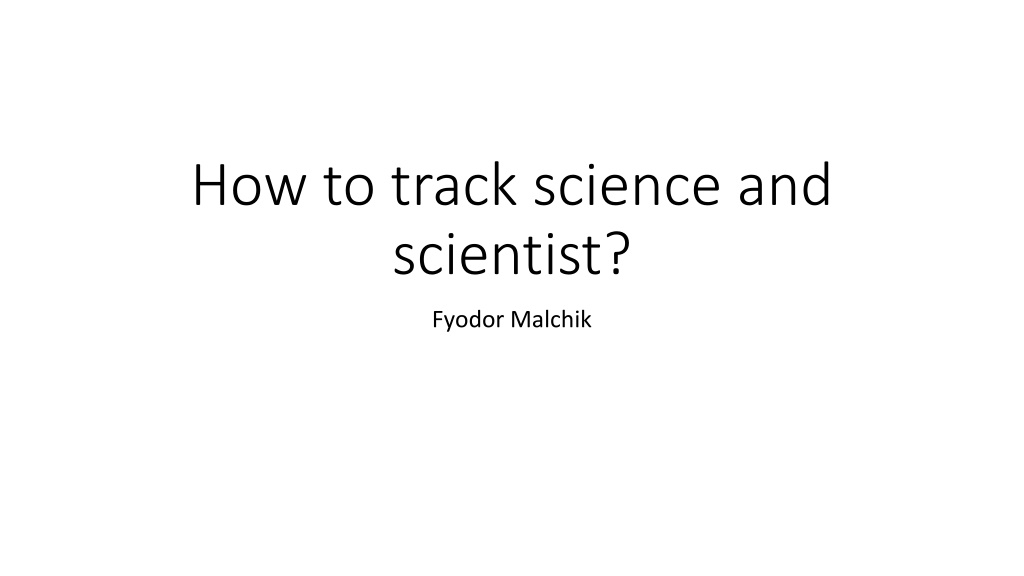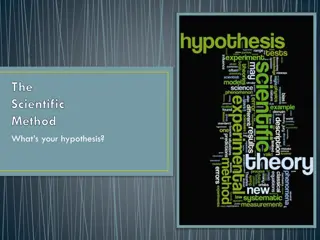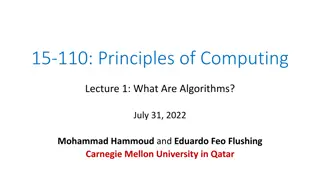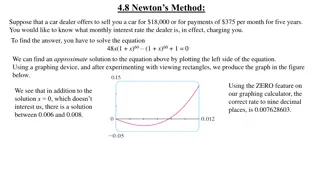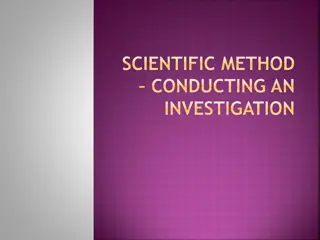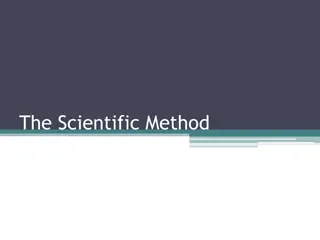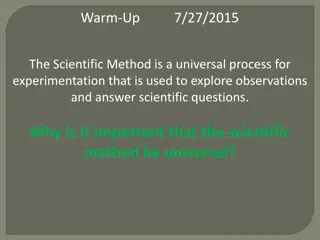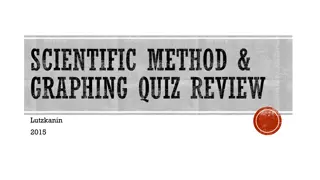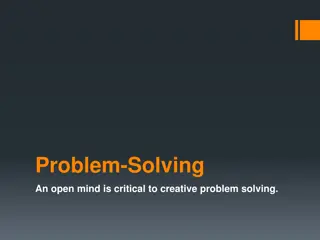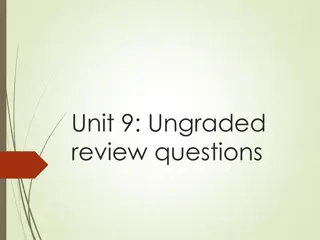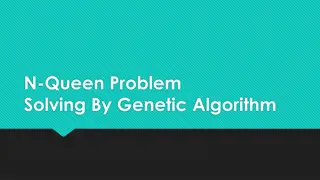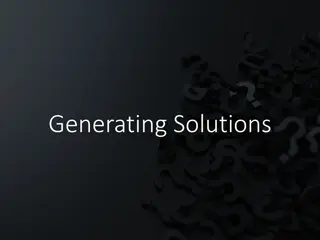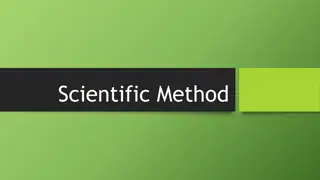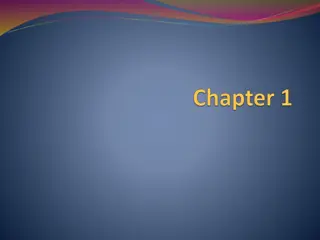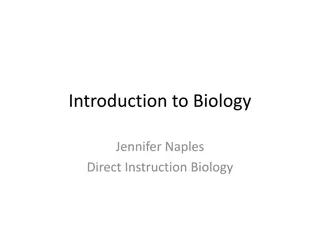Understanding the Scientific Method and Its Importance in Problem-Solving
The scientific method is a systematic approach used by scientists to solve problems and find answers in a logical manner. It involves steps like stating the problem, researching, forming hypotheses, conducting experiments, and drawing conclusions. By following this method, individuals can apply critical thinking and data-driven reasoning to everyday situations. It helps in understanding the world around us by providing a structured way to investigate and analyze phenomena.
Download Presentation

Please find below an Image/Link to download the presentation.
The content on the website is provided AS IS for your information and personal use only. It may not be sold, licensed, or shared on other websites without obtaining consent from the author. Download presentation by click this link. If you encounter any issues during the download, it is possible that the publisher has removed the file from their server.
E N D
Presentation Transcript
How to track science and scientist? Fyodor Malchik
The Scientific Method What s your hypothesis?
What is the Scientific Method? The Scientific Method is the backbone to every science experiment. It is a methodical framework to solve problems and determine answers in a step-by-step logical format.
Why Do We Need It? Have you ever had to friends who attended the same event give you completely different reports of what happened? Everyone has different beliefs, values, and perceptions of the world. While these differences are what make us each unique, they make it difficult to determine what is true and what s not. Scientists over centuries have faced this issue, so to solve the problem they created the Scientific Method.
Do You Already Use It? You probably use the scientific method in everyday life without even realizing it. Let's say that one night you feel like reading in bed, but your mom has already told you three times that it's late and you need to keep your light out and go to sleep. Because you know you're not going to be able to sleep regardless of what your mom says, you reach under the bed for your handy flashlight and flip the switch to turn it on. Nothing happens. Now you're faced with the problem of not being able to read because your flashlight doesn't work, and you're not happy about it. Having identified the problem, you think back to the last time your flashlight didn't work, and you remember that it was because of worn-out batteries. You guess that worn-out batteries are the reason your flashlight isn't working now, so you get some new batteries from the drawer next to your bed and replace the ones in your flashlight. Presto! Your flashlight works. Without realizing it, you've just worked through the steps of the scientific method to solve a problem.
How? When your flashlight wouldn't turn on, you knew you had a problem. Your research was conducted when you thought back to the last time your flashlight didn't work and remembered that you needed new batteries. Next, you came up with a hypothesis (an educated guess) that you needed new batteries this time, as well. You conducted your experiment when you replaced the batteries and turned the flashlight on. When the flashlight worked, you reached the conclusion that indeed, it had needed new batteries. You completed the scientific method and proved your hypothesis to be correct. You also got to finish that great book you were reading! So you see, the scientific method is not mysterious or difficult, although you can use it to work through some difficult problems
Scientific Method Steps 1. State the Problem - Also known as the Purpose 2. Research the Topic 3. State your Hypothesis 4. Experiment Test your Hypothesis 5. Analyze your Data 6. Come to a Conclusion
1. Purpose State the problem that you are attempting to solve. Be specific and avoid broad statements, the more specific your problem the easier you will find a starting point to solve it. Ex: Broad Statement In what conditions do plants grow best? This statement is so general that it is almost impossible to design an experiment. Ex: Specific Statement Do bean plants grow better in direct sunlight, indirect sunlight, or shade? This statement has narrowed down the problem to one plant and one factor determining its growth, making the problem one easily solved through experimentation
2. Research After stating your problem it is important to research your topic. This allows you to form an intelligent hypothesis. Document your research well by citing all sources used to formulate your ideas. Use a variety of sources; books, webpages, newspaper articles, journals.
3. Hypothesis A hypothesis is an educated guess about the outcome of your experiment, based on your knowledge and research conducted. Your hypothesis should be a clear and simple statement. (Not a question) It should only state what you think your results will be, not why you think you will get those results. Example: Bean plants will grow better in direct sunlight than in indirect sunlight or shade. It is understood that your hypothesis is an educated guess, so it is unnecessary to say, I think that or I believe etc. in your hypothesis. Use the words if and then to create your statement.
What If My Hypothesis is Wrong? Guessing incorrectly does NOT make your experiment wrong! Do not change your hypothesis if it turns out to be incorrect. Changing your hypothesis defeats the purpose of the scientific method. Your hypothesis can be right or wrong, it s all a part of the scientific method.
4. Experiment Develop a procedure to test your hypothesis. It is important to list and have all materials needed to conduct the experiment properly. Accurate measurements must be taken to ensure valid experimental results. Be sure to address safety concerns, and take all precautions necessary to ensure your experiment is safe to complete.
Experiment Write a procedure to follow, number each step so that others are able to repeat your experiment by reading the procedure. Control your variables A variable is anything that can change during an experiment. So each time you test everything should be the same except the one variable that you are testing. Independent Variable (IV): The variable that is controlled or manipulated by the experimenter. Dependent Variable (DV): The variable that is measured by the experimenter. Control Group (CG): The group that is not exposed to the independent variable.
Wait What? Here is an easier way to visualize the concept of the independent and dependent variable relationship. Independent Variable Dependent Variable Manipulated Measured Cause Effect Before After Input Output What you do What happens
Practice A group of students were given a short course in speed-reading. The instructor wondered if a monetary incentive would influence performance on a reading test taken at the end of the course. Half the students were offered $5 for obtaining a certain level of performance on the test, the other half were not offered money. Independent Variable (IV): Monetary incentive ($5 or no money). (This is the manipulated variable.) Dependent Variable (DV): Performance on reading test. (This is the variable that can be measured by the experiment.) Control Group (CG): $0, no monetary incentive group. (This group was not affected by the IV.)
Now Try It Again! A researcher is studying the effect of sleep on aggression, thinking that less sleep will lead to more aggression. She has some people sleep 6 hours per night, some people sleep 3 hours per night and some people sleep as much as they want. She then monitors aggressive behavior during basketball games among participants. Independent Variable (IV): Letting some people sleep only 3 hours, and others only 6 hours. The researcher manipulates this variable. Dependent Variable (DV): Aggression (or aggressive behavior). The experimenter is monitoring (i.e., measuring) aggressive behavior. Control Group (CG): The people that got to sleep as much as they wanted. This is the group that was not exposed to the independent variable.
5. Analysis Record the results of the experiment. This is done in a data table or chart. Organize data well so that finding results and trends is easier. Take thorough and accurate measurements during the experiment so that the data is valid. Find associations and trends in your data. Make connections about the experiment and your results.
6. Conclusion Compare the hypothesis to the experiments conclusion. State if you proved or disproved your hypothesis. Name any errors that could have been made during the experiment or results that could have affected your outcome.
Now you are an expert on the Scientific Method!
